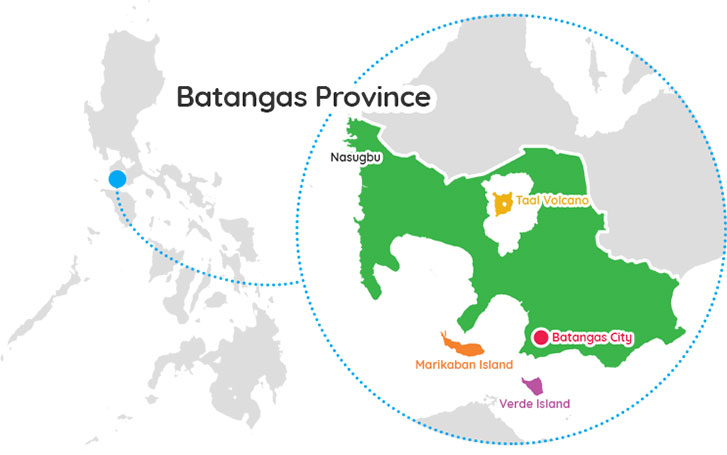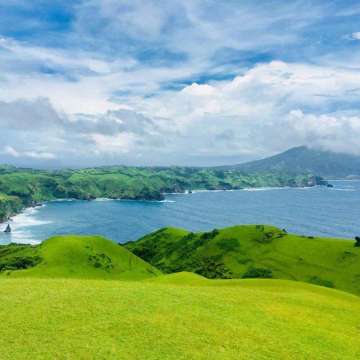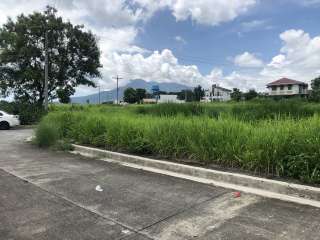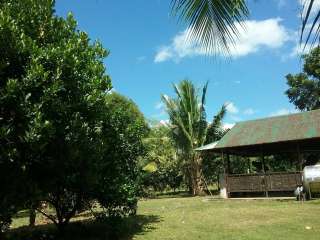About batangas

Batangas, officially the Province of Batangas, is a first class province of the Philippines located on the southwestern part of Luzon in the CALABARZON region. Its capital is the city of Batangas, and is bordered by the provinces of Cavite and Laguna to the north, and Quezon to the east. Across the Verde Island Passages to the south is the island of Mindoro and to the west lies the South China Sea. Poetically, Batangas is often referred to by its ancient name, Kumintáng.
The name Batangas is derived from the term batangan, which has two definitions: a log found in the Calumpang River, the rafts used to fish in Taal Lake.
The Batangas dialect of Tagalog closely resembles the Old Tagalog spoken before the arrival of the Spanish. This is why the Summer Institute of Linguistics calls this province the center of the Tagalog language. The strong presence of Tagalog culture is evident to this day.
Batangas also has one of the highest literacy rates in the country at 96.5%, with men having a slightly higher literacy rate at 97.1% compared to women at 95.9%. The combined average literacy rate is 96%.
Batangas is one of the most popular tourist destinations near Metro Manila. It is home to the well-known Taal Volcano, one of the Decade Volcanoes, and the small nearby town of Taal which keeps ancestral houses, churches, and other architecture dating back to the 19th century. The province also has numerous beaches and diving spots including Anilao in Mabini, Sombrero Island in Tingloy, Ligpo Island and Sampaguita Beach in Bauan, Matabungkay in Lian, Punta Fuego in Nasugbu, Calatagan and Laiya in San Juan. All of the marine waters of the province are part of the Verde Island Passage, the center of the world's marine biodiversity.
Batangas City has the second largest international seaport in the Philippines after Metro Manila. The identification of the city as an industrial growth center in the region and being the focal point of the Calabarzon program is seen in the increasing number of business establishments in the city's Central Business District (CBD) as well as numerous industries operating in the province's industrial parks. Lipa City has passed Batangas city as the most populous city in the province.
History
Large centers of population already thrived along the coasts and rivers of present-day Batangas. Barangays lined the Pansipit River draining Bombon Lake (now Taal), a major waterway. The area was a major site for the Maritime Jade Road, one of the most extensive sea-based trade networks of a single geological material in the prehistoric world, operating for ~3,000 years from ~2000 BCE to ~1000 CE. Trading relations with other Philippine peoples, Borneo, Chinese, Japanese, among others were maintained.
Archaeological findings and written accounts by the Spanish explorers in the mid-16th century show that pre-colonial Tagalogs have long histories in complex, stratified societies with trade networks encompassing Southeast and East Asia. This was shown by certain jewelry, made from a chambered nautilus' shell, where tiny holes were created by a drill-like tool. The ancient peoples of present-day Batangas were influenced by trade with Indianized states and to a lesser degree China, as shown in many loanwords from Sanskrit and unearthed tradeware ceramics primarily from China and present-day Vietnam and Thailand. A Buddhist image unearthed in Calatagan was reproduced in mould on a clay medallion in bas-relief. According to experts, the image in the pot strongly resembles the iconographic portrayal of Buddha in Siam, India, and Nepal. The pot shows Buddha Amithāba in the tribhanga pose inside an oval nimbus. Scholars also noted that there is a strong Mahāyānic orientation in the image, since the Boddhisattva Avalokiteśvara was also depicted.
In 1570, Spanish generals Martin de Goiti and Juan de Salcedo explored the coast of Batangas on their way to Manila and came upon a settlement at the mouth of Pansipit River. In 1572, the town of Taal was founded and its convent and stone church were constructed later.
Officially, the Province of Bonbon was founded by Spain in 1578, through Fr. Estaban Ortiz and Fr. Juan de Porras. It was named after the name that was given to it by the Muslim natives who inhabited the area.
In 1581, the Spanish government abolished Bonbon Province and created a new province which came to be known as Balayan Province. The new province was composed of the present provinces of Batangas, Mindoro, Marinduque, Romblon, southeast Laguna, southeast Quezon, and Camarines. After the devastating eruption of Taal Volcano in 1754, the old town of Taal, present day San Nicolas, was buried. The capital was eventually transferred to Batangas (now a city) for fear of further eruptions where it has remained to date.
The town of Nasugbu became an important centre of trade during the Spanish occupation of the country. It was the site of the first recorded battle between two European Forces in Asia in Fortune Island, Nasugbu, Batangas. In the late part of the 20th century, the inhabitants of Fortune Island discovered a sunken galleon that contained materials sold in the Manila-Acapulco Galleon Trade.
Batangas was also among the first of the eight Philippine provinces to revolt against Spain and one of the provinces placed under Martial Law by Spanish Governor-General Ramon Blanco on August 30, 1896. This event was given distinction when Marcela Agoncillo, also a native of the province, made the Philippine Flag, which bears a sun with eight rays to represent these eight provinces.
Members from batangas
Listings in batangas
More Provinces

batanes
Batanes, officially the Province of Batanes, is an archipelagic province in the Philippines, administratively part of the Cagayan Valley region. It is the northernmost province in the Philippines, and the smallest, both in population and land area. The capital is Basco, located on the island of Batan. The name Batanes ...read more

benguet
Benguet, officially the Province of Benguet, is a landlocked province of the Philippines located in the southern tip of the Cordillera Administrative Region in the island of Luzon. Its capital is La Trinidad. The highland province is known as the Salad Bowl of the Philippines due to its huge production ...read more

























